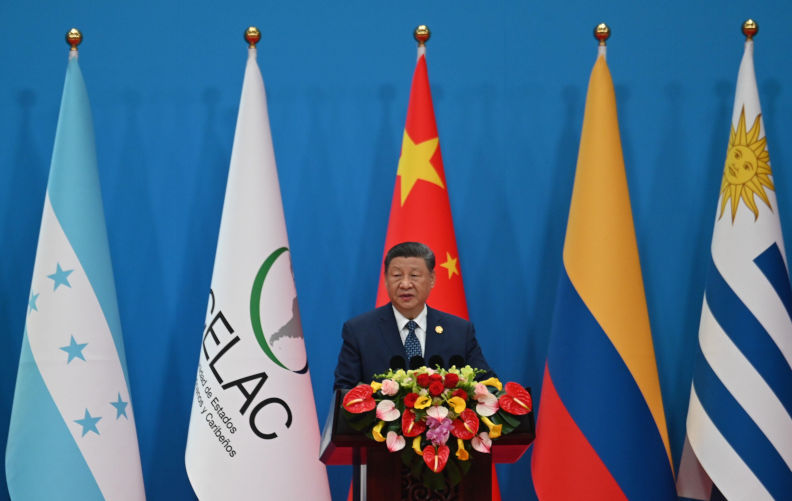China is increasingly present in US Latin American backyard
June 17, 2025
From the time when US President James Monroe announced what has become known as the Monroe Doctrine in 1823, warning European states to stay out of the hemisphere, the US has considered Latin America to be its backyard.
That is now rapidly changing as China becomes increasingly involved. The change has been as rapid as it has been momentous.
In contradistinction to the US however, China’s focus is on soft power – a development framework centred on aid, investment, trade, as well as cultural and educational ties, rather than military means.
Trade relations between China and Latin America have grown massively from just US$12 billion in 2000 to US$235.9 b in 2015, before more than doubling to US$489.1b in 2023. By 2035, it is widely predicted China will overtake the US as Latin America’s largest trading partner.
When it comes to the Mercosur countries (Argentina, Bolivia, Brazil, Paraguay, and Uruguay), China, accounting for 26.7% of the bloc’s external trade in 2023, up from 24.1% in 2018, has surpassed both the EU (16.9 % of the bloc’s external trade, down from 20.1 % in 2018) and the US (13.9 % of the bloc’s external trade, down from 14.4 % in 2018).
Latin America holds strategic importance for the future of the global economy due to its abundance of resources and critical raw materials, such as lithium and copper. In resource-rich South America — Argentina, Bolivia, Brazil, Chile, Colombia, Ecuador, Guyana, Paraguay, Peru, Suriname, Uruguay and Venezuela — China is the region’s top trading partner.
In 2018, China extended its major global infrastructure development strategy — the Belt and Road Initiative — to Latin America, where to date, 21 out of the 33 LAC countries have signed up to the initiative.
BRICS+ represents another important link between China and Latin America. In addition to the founding member Brazil, two other LAC countries, Cuba and resource-rich Bolivia, joined in February 2025 as partner countries. Argentina, however, under the extreme right-wing leader Javier Milei, has rejected the invitation to join as a full member.
In addition China has signed nearly 1000 bilateral agreements with LAC countries to facilitate and promote trade, investment and co-operation across a wide range of sectors. These include Comprehensive Strategic Partnerships with Argentina, Brazil, Chile, Ecuador, Mexico, Peru, Uruguay and Venezuela.
Making his sixth visit to the region since 2013, Xi Jinping has visited more frequently than US Presidents Obama, Trump and Biden combined.
A crucial piece of Chinese strategic investment in the region is the Chancay megaport in Peru, majority-owned by the Chinese state shipping company Cosco, which will reroute trade between Latin America and Asia, bypassing the Atlantic and the Panama Canal, with Brazil aiming to build a railway link to the port. US President Donald Trump has made much of Chinese interests in the Panama Canal, threatening “to take it back”. Again, the US seems to be a step behind.
Both being a result of and driving much of the change has been the China-CELAC (Community of Latin American and Caribbean States) whose Fourth Ministerial Meeting was held on 13 May in Beijing, marking the 10th anniversary of the first meeting of the first China-LAC summit in Brasília, Brazil.
Included among those at the gathering were Xi Jinping, who in an opening address welcomed and outlined his vision for the grouping, Chinese Foreign Minister Wang Yi, who chaired the meeting, along with Brazilian President Lula da Silva, also making a state visit to China, Colombian President Gustavo Petro, and Chilean President Gabriel Boric. All 33 member states of CELAC were present, a contrast with the more restrictive approaches promoted by the US, which, during the IX Summit of the Americas (2022), excluded Cuba, Venezuela, and Nicaragua.
Xi spoke of the importance of Chinese initiatives, Belt and Road, the Global Development Initiative and the Global Security Initiative in building relations between China and the Bloc as part of Global South co-operation. He outlined co-operation, built around five strategic programs; political, economic, social, cultural, and security, while also announcing a credit line of 66 billion yuan (US$9.2 billion) to support regional development. Singling out Donald Trump without explicitly naming him, Xi remarked that, “bullying and coercion only lead to isolation”.
Wang Yi called for rejection of bloc confrontation, advocating instead for a new style of international relations, an openness with win-win results, co-operation among the Global South, with an emphasis on safeguarding common rights and interests.
China, he concluded, opposes power politics and interference in internal affairs. Such attitude contrasts strongly with Latin American experience of the US which has often run interference, fermenting coups and unrest in the region, from Chile, Argentina, Uruguay, Nicaragua, El Salvador and Grenada, to Venezuela and Bolivia.
Responding, LAC leaders showed appreciation for China’s commitment to the spirit of equality, openness and partnership around infrastructure, economy, trade, investment, education, training, scientific and technological innovation, green energy, medical care, health, and disaster prevention and mitigation.
Still caught in an adversarial relationship to the region, the US State Department announced on 15 May that the US would oppose any funds from multilateral lenders, such as the Inter-American Development Bank, for Chinese companies in Colombia and other countries in the region that have joined BRI. Pete Hegseth, the US Secretary of Defence, has said China’s activity in the Western Hemisphere is “for military advantage and unfair economic gain”.
As a result of the meeting, two key documents were adopted: the Beijing Declaration and a Joint Action Plan 2025-27 approved by all 33 participating countries – with the exception of Argentina, which chose not to endorse the documents.
Latin America, which for 200 years from the pronouncement of the Monroe Doctrine has been regarded as the US backyard, is increasingly looking for a different neighbourhood.
The views expressed in this article may or may not reflect those of Pearls and Irritations.

